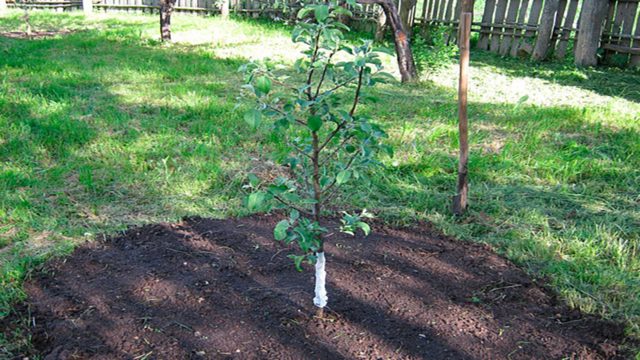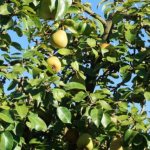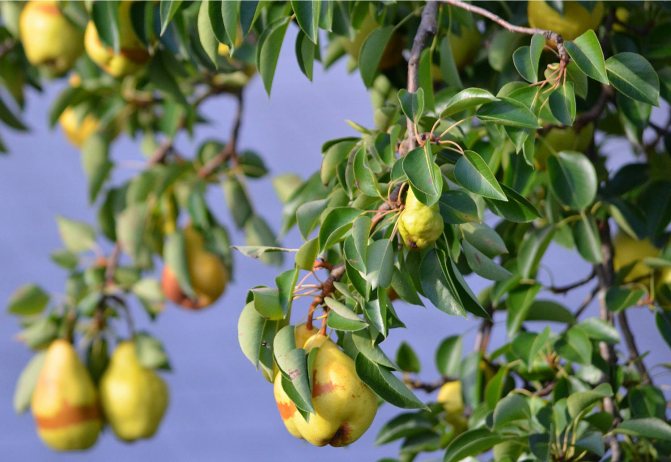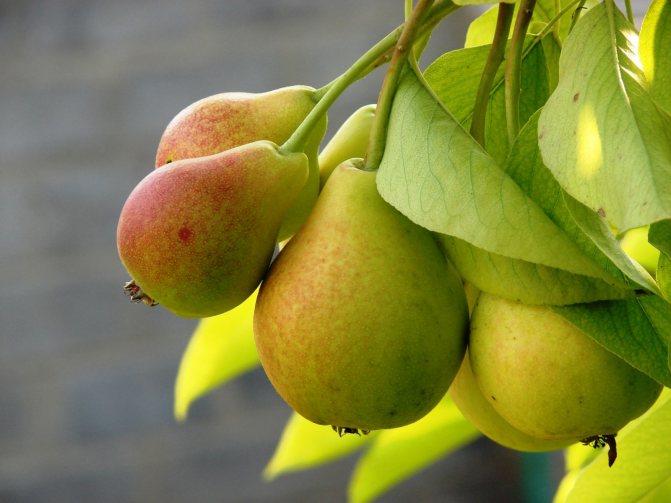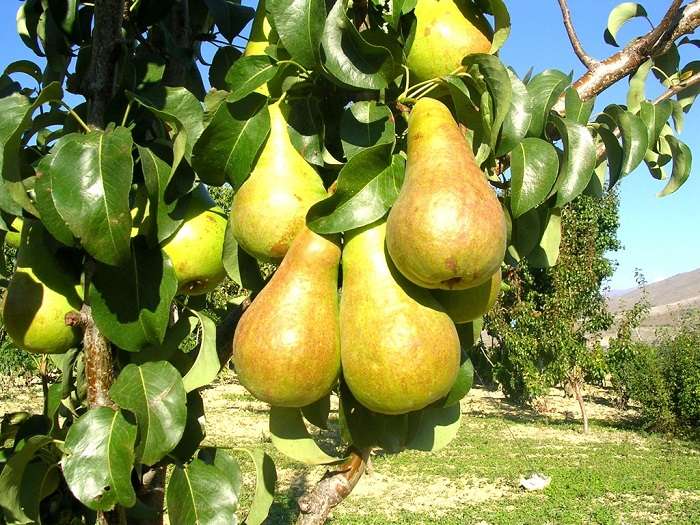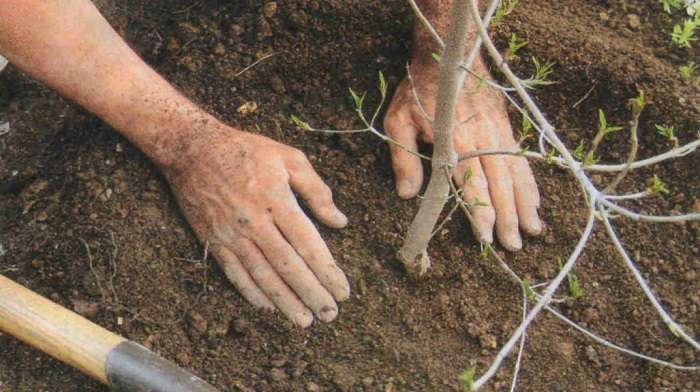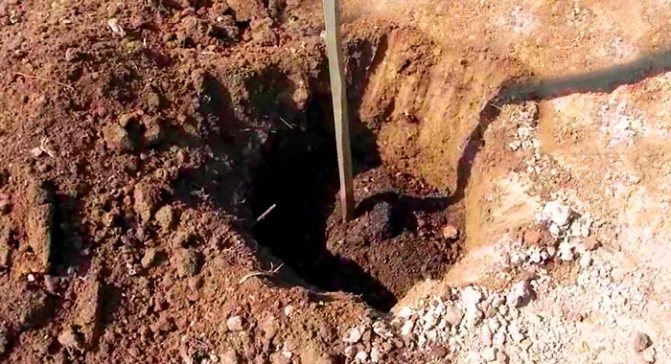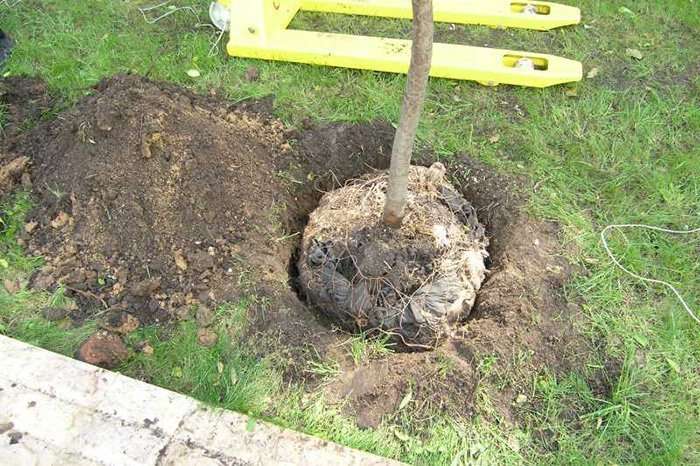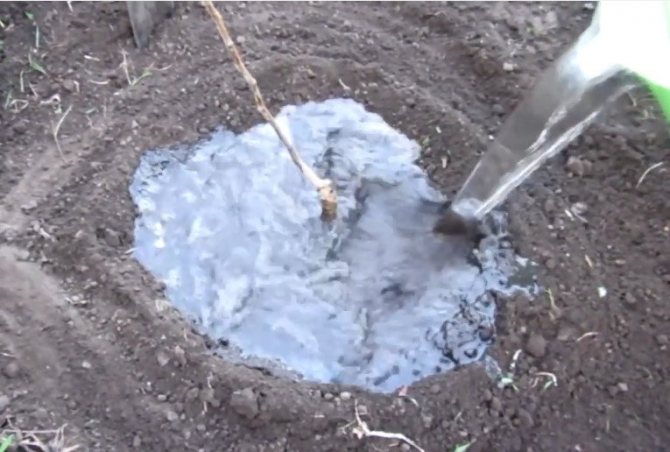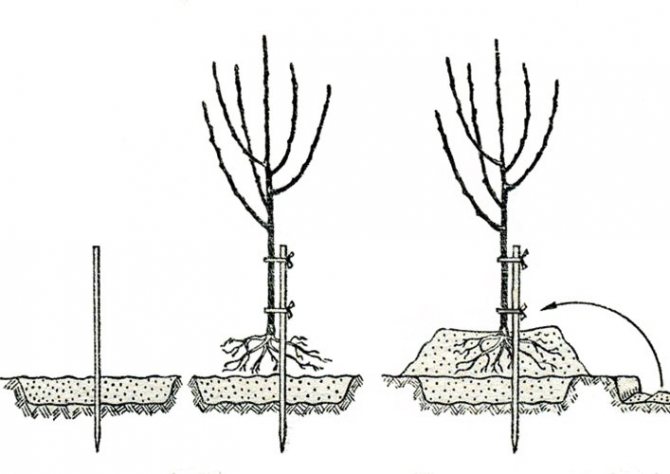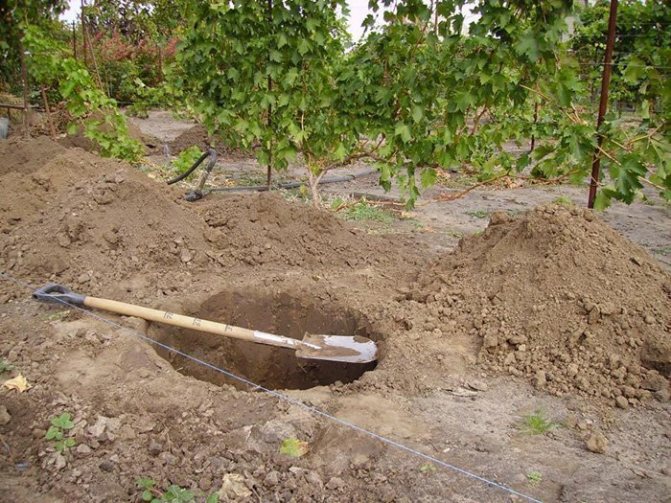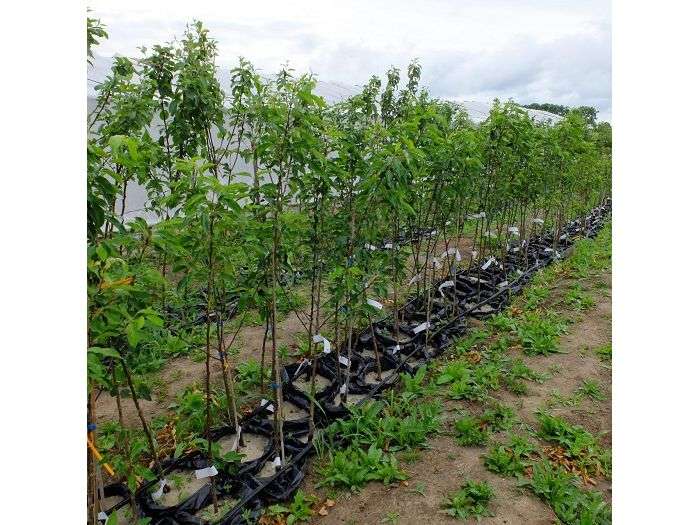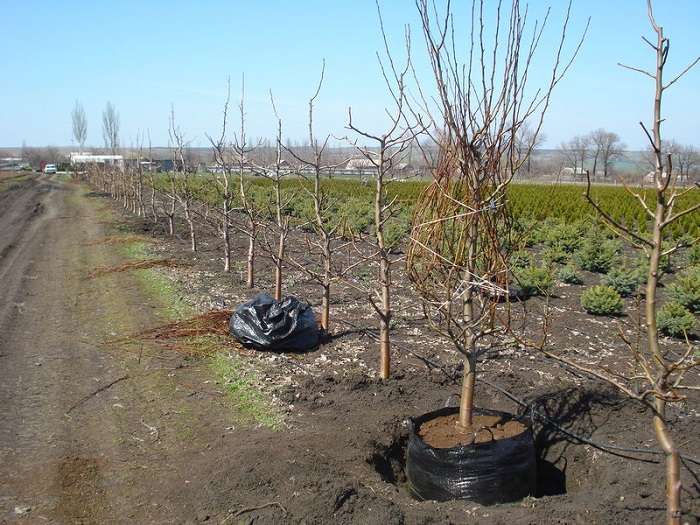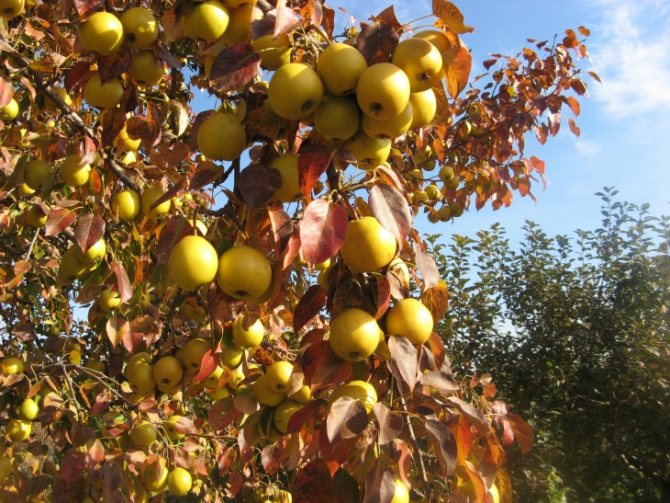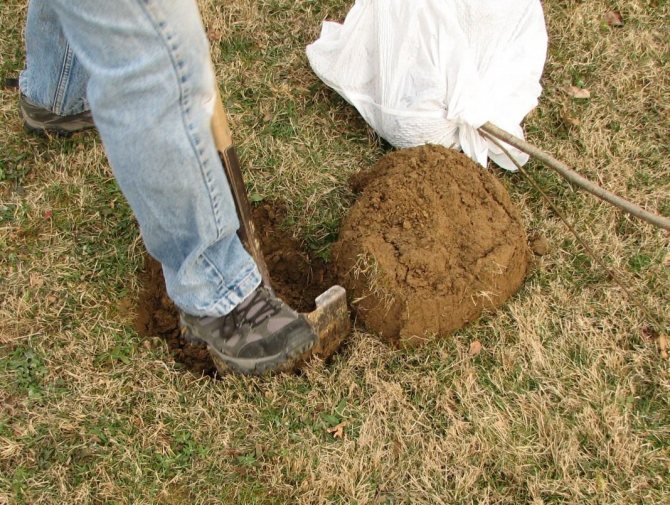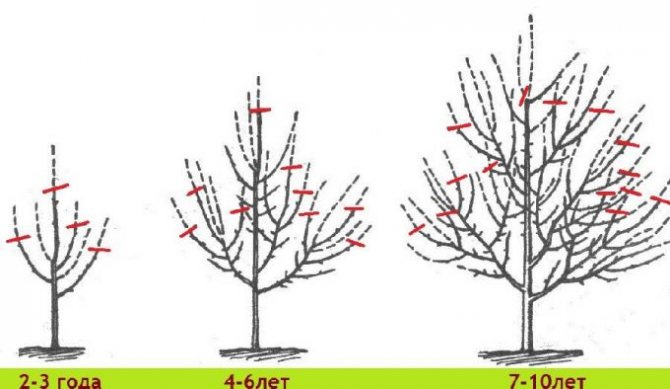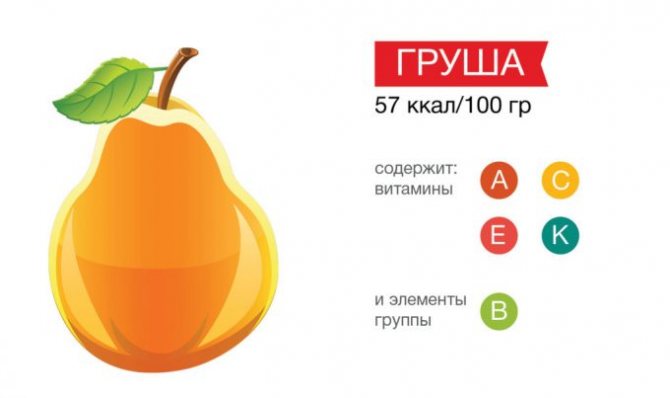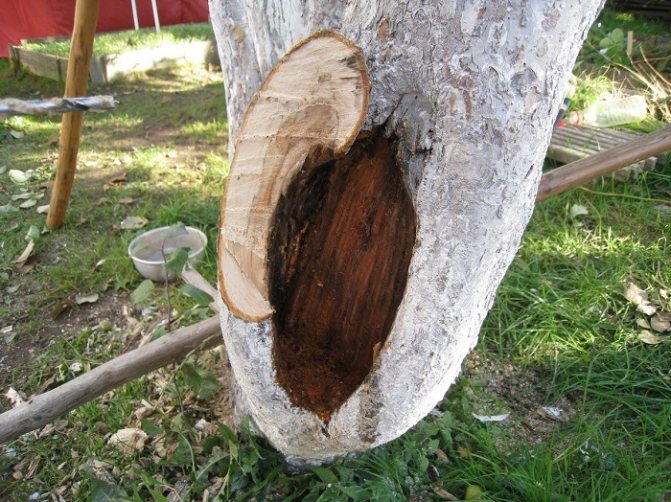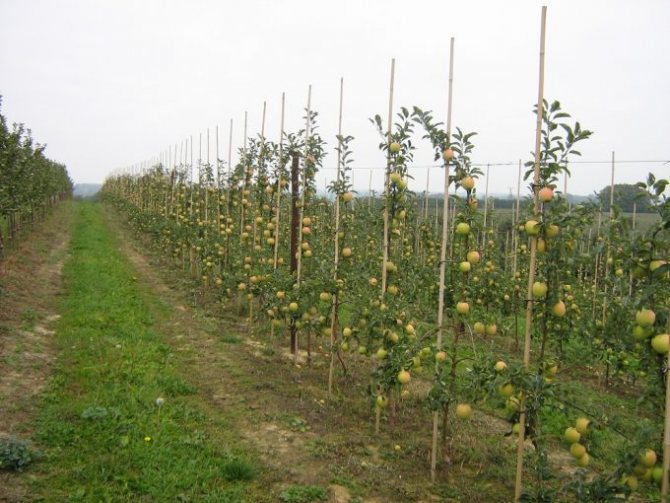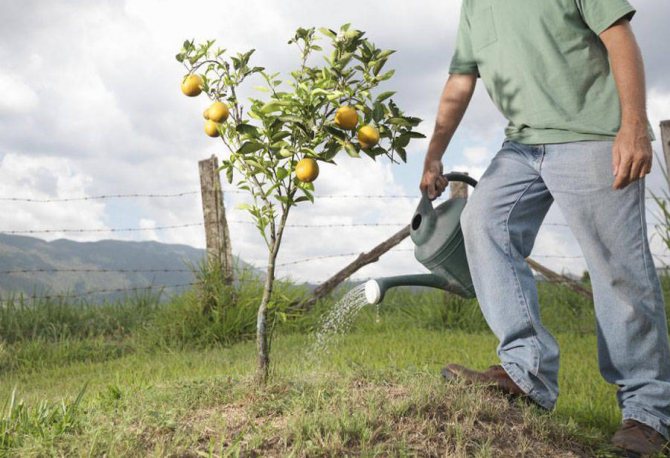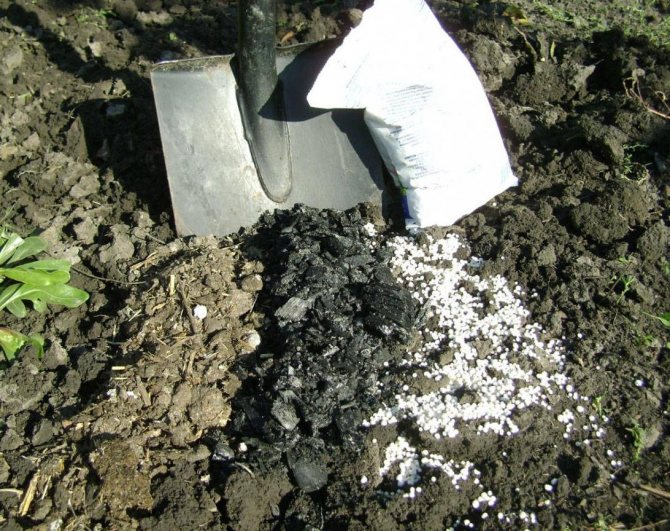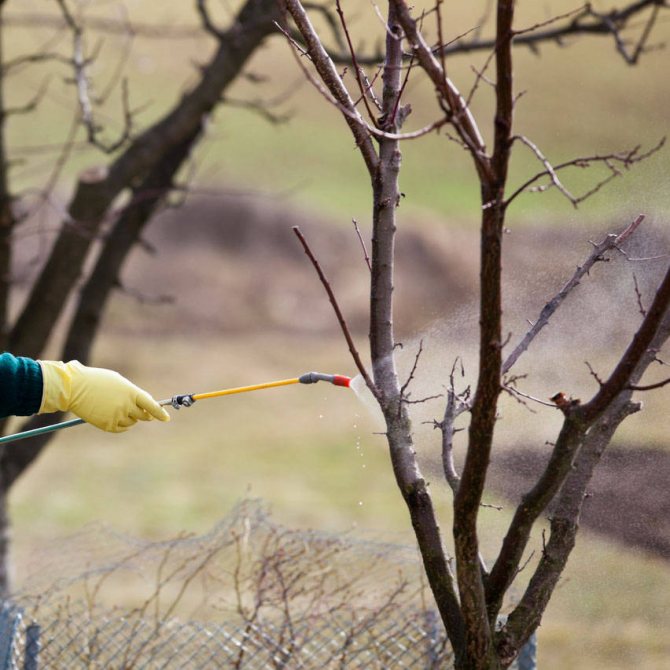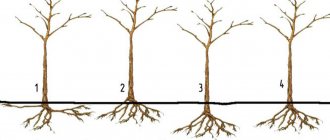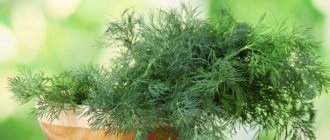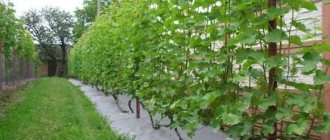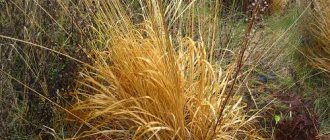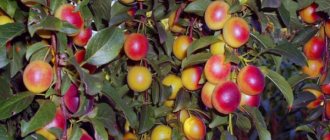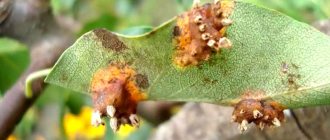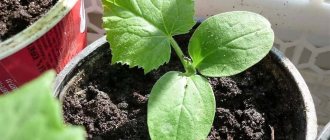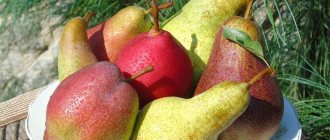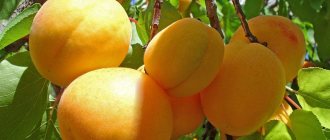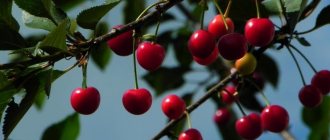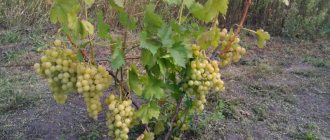Planting a pear correctly means providing the tree with favorable conditions for growth and abundant fruiting. A comfortable place, a well-chosen substrate, and a spacious planting pit are the basic requirements. The process of placing a tree is slightly different in different climates.
When can you plant a pear
Gardeners decide to plant a pear in the spring or fall, depending on the weather. If the frosts are early, the tree will not have time to take root; only spring planting is suitable in the region. Based on the climate, the spring planting of pears is carried out from late March to mid-May. There is a general requirement: trees are planted when the air warms up to 5 ° C. In the south, they refrain from planting in spring. Here, the heat sometimes sets in already in April, so the seedling suffers a lot of stress due to the hot air. In the middle lane, it is recommended to plant pears from April 18-22 to May 10-12.
Spring planting has several benefits:
- in warm weather, the tree quickly adapts and takes root;
- during the warm season, it will build up a powerful root system and enter the winter strong;
- after snow, there is a lot of moisture in the ground, which helps to activate biological processes;
- throughout the warm season, they monitor the condition of the seedling, water it on time, protect it from pests and diseases.
In addition to the advantages of spring planting, there is also a disadvantage: the tree must simultaneously root and develop green mass. Hence the increased requirements for the quality of the seedling:
- pay close attention to the condition of the trunk and kidneys;
- select specimens with a developed root system;
- or buy trees in containers.
Sapling selection
Choose healthy trees for planting. In the south, it is better to plant a one-year-old pear seedling, a two-year-old is suitable for planting in the north. The trunk must be carefully checked, it must be free of damage, irregularities, its height must reach 80-85 cm.
Be sure to check the roots of the seedling. Healthy roots bend without problems, there are no dry parts on them, they are white at the cut. Seedlings are planted both in autumn and spring, but the best choice of materials for planting is in the fall.
A step-by-step guide on how to plant a pear in spring
Although the tree is not capricious, planting a pear in open ground in the spring requires attention. Several parameters are provided: place, soil mixture, position relative to other plants and buildings.
Where can you plant a pear on the site
Trees of the genus after 6-7 years do not tolerate transplantation, therefore, they carefully choose a place for a seedling. To properly plant a pear in spring, take into account:
- an open and spacious place is needed, since the taste of the fruits depends on the amount of sunlight they receive, and they gain more or less sugars;
- groundwater is not higher than 3 m, because the root goes deep into the ground, and when the moisture is close, the seedling dies;
- a corner protected from sudden gusts of wind.
The latter condition is relevant for planting a tree in spring in Siberia or the Urals. A pear can tolerate - 25-28 ° C, but not in a windy place. An important requirement for good fruiting pears is planting close, up to 30 m, pollinators of a suitable variety.
At what distance to plant pears from each other
In the garden, the average spacing is 3-5 m.Columnar pears are planted thicker, up to 1 m between seedlings. When choosing a place for a tree, it must be remembered that the shade and the accompanying coolness can cause the development of fungal diseases. Pits are dug at least 3 m from buildings, as well as at a distance, up to 10 m, from tall and spreading walnuts or ornamental trees. If such plants are located from the north, the distance is halved.
Shrubs such as barberry, lilac, chubushnik, currant, raspberry and others are not close to the pear. A wide pear crown, at least 5-6 m in height, will oppress the neighboring low plants. With a mass planting of pears, the distance between trees in a row is 5 m, the spacing between rows is 6 m.
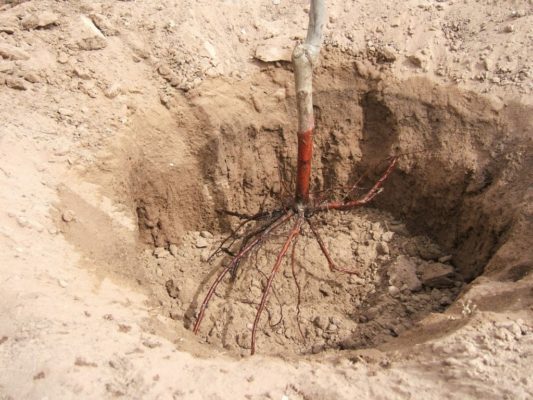
Planting pit preparation
After the hole has been dug, first, drainage is laid in a layer of up to 15 cm, and then a soil mixture is prepared. The ideal substrate for pears is loose loam or sandy loam with a slightly acidic or neutral reaction. If the soil differs in parameters, imported soil - black soil or clay - is introduced into a hole measuring 60x70x90 cm and mixed with sand in a ratio of 2: 1. Also add 1 part of the removed top layer of garden soil and 2 parts of caked humus or compost.
Fertilize:
- 1.5 cups superphosphate;
- 2-3 tablespoons of potassium sulfate.
The acidic soil is alkalized by stirring 600 g of dolomite flour or 200 g of slaked lime in a bucket of water. When the mixed substrate is laid in the pit, it is spilled with the prepared mixture. The procedure is carried out, if not six months before planting, then at least 1 week.
A warning! Soils with high acidity or alkaline are not suitable for pears.
How to properly plant a pear seedling in the spring
A pear seedling is sensitive to the deepening of the root collar into the ground, so a pit with a substrate is prepared in advance. If an unplanned planting is carried out, the soil under the tree is carefully compacted. The soil settles immediately and does not subsequently pull the root collar down.
If the groundwater is higher than 2 m, a hill with a height of up to 0.5-1 m is poured on the intended area. A planting hole and a substrate are prepared from above. A drainage 10-15 cm high is placed on the bottom, a soil mixture is placed on top.
On the day of planting, part of the substrate is set aside for dusting the roots and the following actions are performed:
- form a small mound;
- drive in a peg from the south side, stepping back from the center of the pit, where the trunk will be, 10-15 cm;
- pour out a bucket of water and wait until it is absorbed;
- put and spread pear roots;
- the root collar is 6 cm above the level of the garden soil;
- sprinkle the roots with earth, slightly shaking the trunk so that there is no air space between the roots and the soil;
- tie up a seedling;
- fill the hole with water and mulch.
Important! If acidic soil predominates on the site, 300-600 g of dolomite flour or 200 g of slaked lime are introduced into the planting pit.
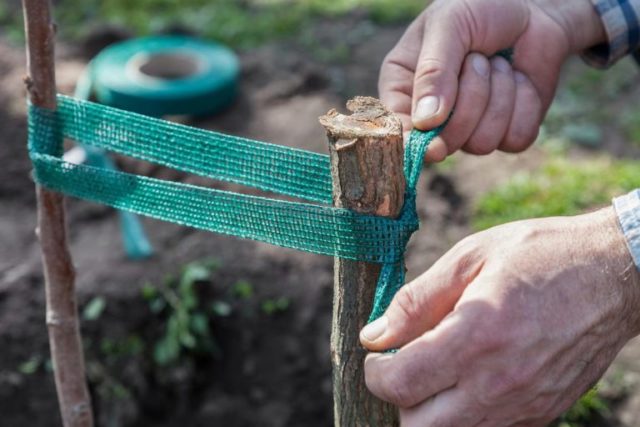

How to plant a columnar pear
The interval between the columnar seedlings is 50 cm, the row spacing is 1.25 m. The requirements for planting this type of pear in the spring are identical to the others. More close attention will have to be paid to the preparation of the seedling:
- it is advisable to purchase only one-year-olds;
- since trees need high humidity, the roots are soaked for 20-24 hours in a solution of 1 tablespoon of potassium sulfate.
The substrate is also enriched with organic matter and potassium-phosphorus preparations.
Rules for transplanting pears to a new place in spring
An undemanding young tree for the next year can still be planted in another, more suitable place. In the fall, they dig a hole and mix the soil with fertilizers. They are transplanted as soon as the weather and soil conditions permit, and the pear buds in the spring only swelled, but did not open. On a cloudy day, they dig in a tree from all sides, chopping off too long root processes. They shed an earthen lump well, preserving its integrity. The seedling is transferred to a new place, the soil is poured, compacted and watered with 15 liters of water near the trunk.To preserve moisture, mulch is placed on top.
How to plant a pear in summer
Container plants are planted at almost any time of the warm season. A prerequisite for planting a pear with a closed root system in summer is to shed an earthen lump. The container is placed in a large container of water until the substrate is saturated with moisture. The seedling, along with the soil around the roots, can be easily removed from the pot. They slightly free the roots from interweaving and spread them on the substrate, filling the hole.
Attention! The seedling may need shading for the first 2-3 weeks if the weather is hot. They use special nets to protect them from direct sunlight.
Landing features in the regions
The pear does not grow in the north, but Siberian gardeners grow zoned varieties. There are some peculiarities of tree planting in the middle climatic zone.
Planting pears in the spring in the suburbs
The best time to place the selected seedling is at the end of April, when there are no leaves on the tree yet. You can plant a pear in the Moscow region in early May, providing thorough care, including regular watering and sprinkling in case of hot weather, or by buying your favorite variety in a container. The region has hot summers and early autumn colds, and winters are frosty, but with thaws. Therefore, zoned varieties with high winter hardiness are selected, which bear fruit in summer and early autumn:
- Muscovite;
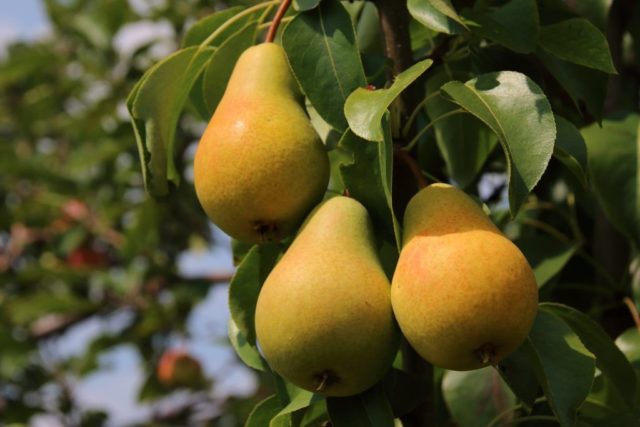

- Lada;
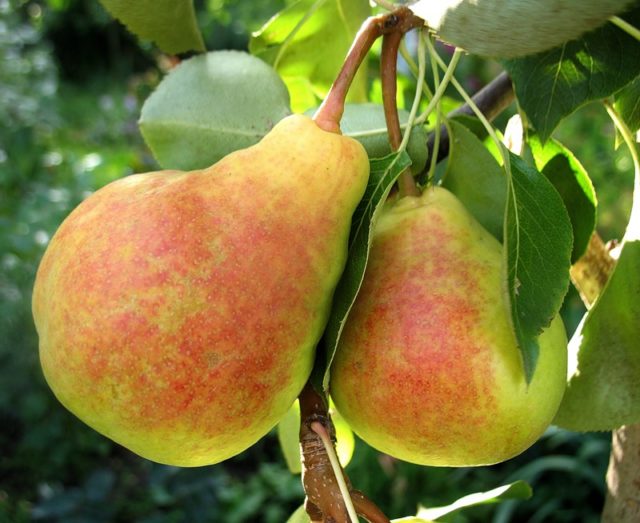

- Cathedral;
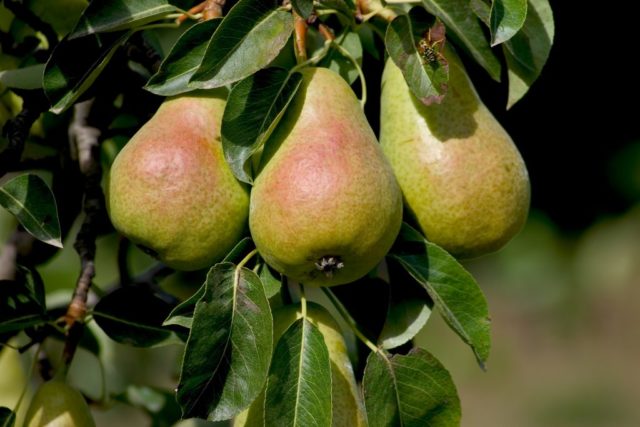

- Chizhovskaya;
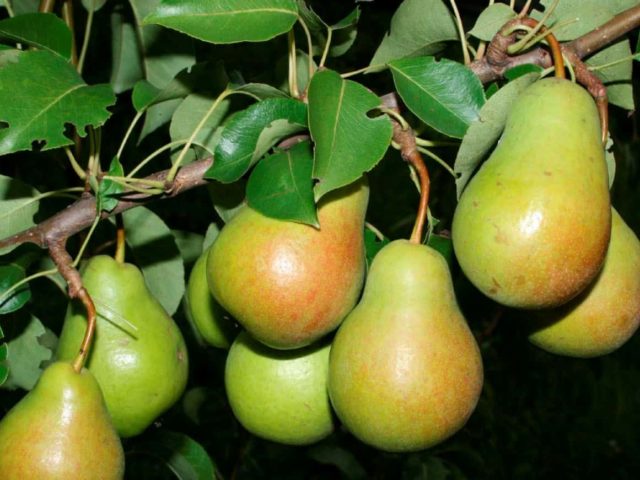

- Space;
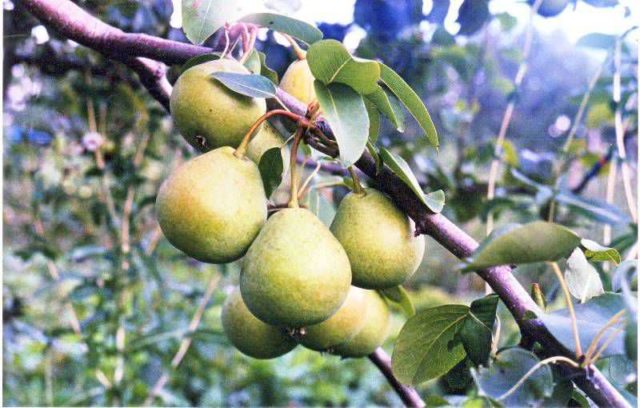

- Elegant Efimova;
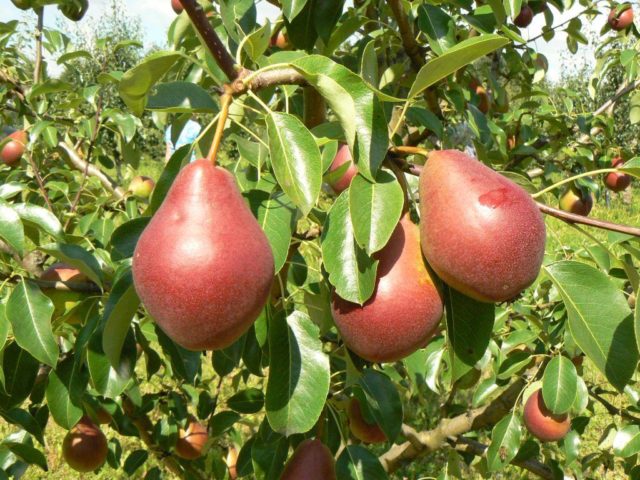

- Otradnenskaya.
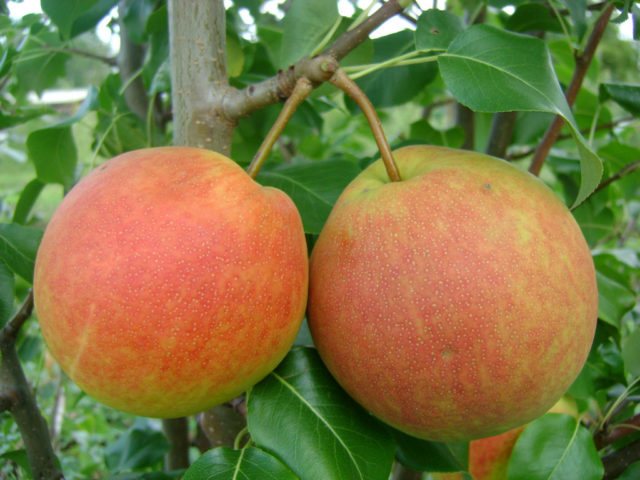

Planting pears in the spring in the middle lane
In most areas of the middle lane, pears of summer-autumn varieties are planted, which ripen before frost. Starting approximately from the latitude of Bryansk to the south, the fruits of any late autumn varieties have time to ripen. Recently, columnar pears have been popular, characterized by frost resistance and early maturity. In temperate climates, planting in spring is encouraged, because over the summer the tree will grow up and acclimatize. When planting in autumn in the northern regions, there is a risk that the seedling will not have time to take root.
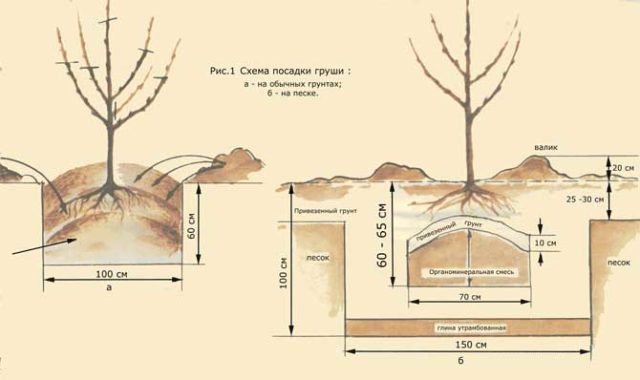

How to plant a pear in Siberia
For the harsh conditions of Siberia and the Urals, it is acceptable to plant pear seedlings in the spring, usually from 5 to 30 May. The climate requires special varieties in terms of parameters:
- frost resistance up to - 30 ° С;
- early maturity, which is inherent in pears of the summer ripening period;
- drought resistance;
- compact and low crown.
The following varieties meet these requirements:
- Autumn Yakovleva;
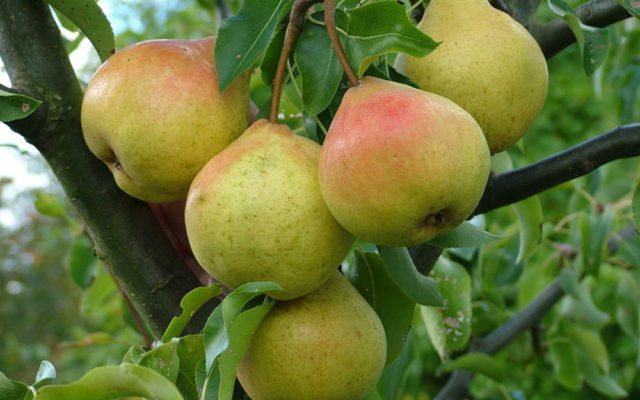

- Severyanka;
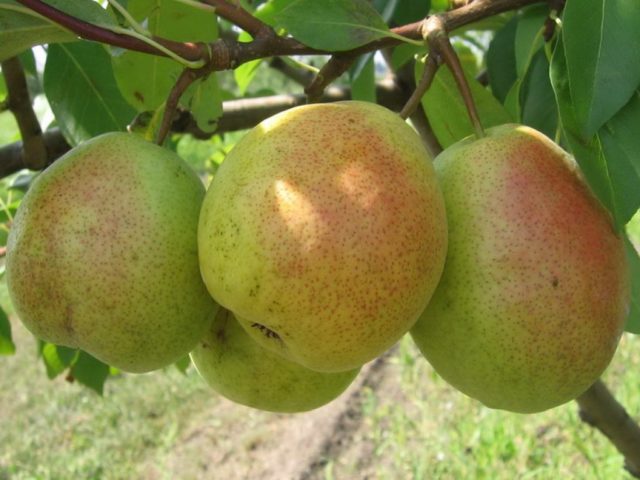

- Autumn Dream;
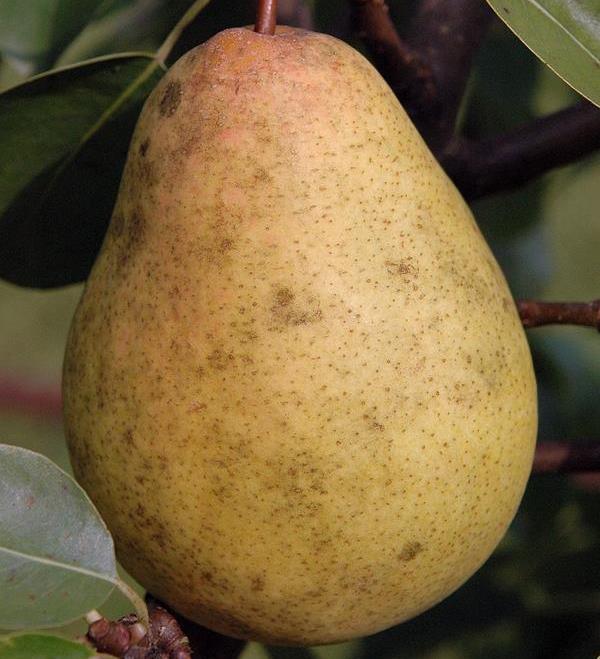

- Firewoman;
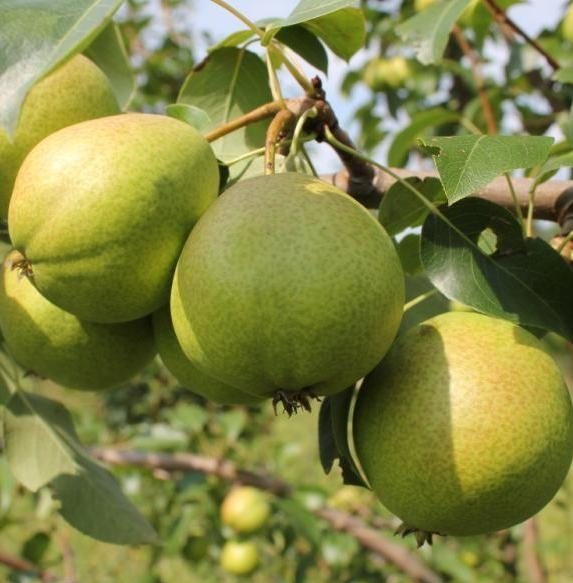

- Svarog.
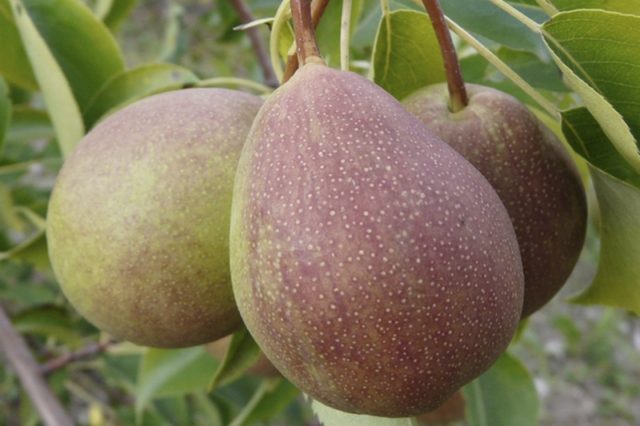

Comment! In the conditions of Siberia and the Urals, it is better to take two-year-old seedlings, as they are more viable.
We choose
There are about 60 varieties of pear trees with different characteristics. The required variety is selected in accordance with:
- climatic conditions of growth;
- soil characteristics;
- individual features of the species.
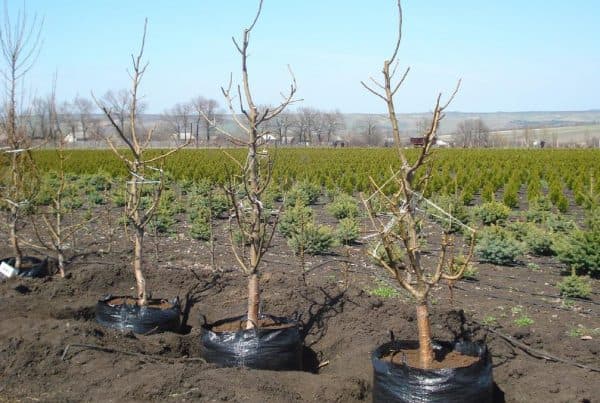

Fruit seedlings are purchased in specialized places or are bred at home.
To increase the fruiting of the tree, it is recommended to plant two varieties of pears at the same time. At the same time, cross-pollination between plants occurs, which has a beneficial effect on productivity.
Purchased
When buying a pear seedling Moskvichka, Rossoshanskaya and other varieties, you should carefully study the plant. The tree for planting should be one or two years old. The seedling should have a clean center stem surface. The root system should not have plaque, which indicates freezing of the plant. A young tree should be free of noticeable damage, dry bark or buds with broken leaves.
It is necessary to look for good planting material in the nursery or in the garden market.
Home
To obtain planting material at home, mature fruit seeds or cuttings are used. Growing seedlings from cuttings is the easiest way. The cultivation process consists of three periods:
- eyepiece stage - cultivated species are cultivated on rootstocks;
- one-year-old stage - annual plants are grown from grafted eyes;
- biennial stage - two-year-old seedlings are grown.
How to care for a pear
The care of the pear after planting is of great importance for the development of the tree and fruiting.
Watering and feeding schedule
In a spring seedling, all processes are quickly activated, which is favorable for the weather. The soil must be moderately moist for the roots to develop and receive adequate nutrition. If there is little rainfall, water the pears in the spring at least 1 time per week. Wood consumption - 20-25 liters. In hot weather, evening sprinkling is carried out. In the first year of growth, pears are not fed.
Weeding and loosening the soil
If the near-stem circles are not mulched, after watering the soil is loosened so that the root system receives enough oxygen. Weeds are removed, a kind of incubators for pests and diseases.
What year after planting does the pear bear fruit?
Fruiting depends on the type of rootstock. Some varieties give a harvest in the second or third year. Usually, the fruiting time of pears begins at 5-6 years. The most abundant collection is observed after 10 years.
